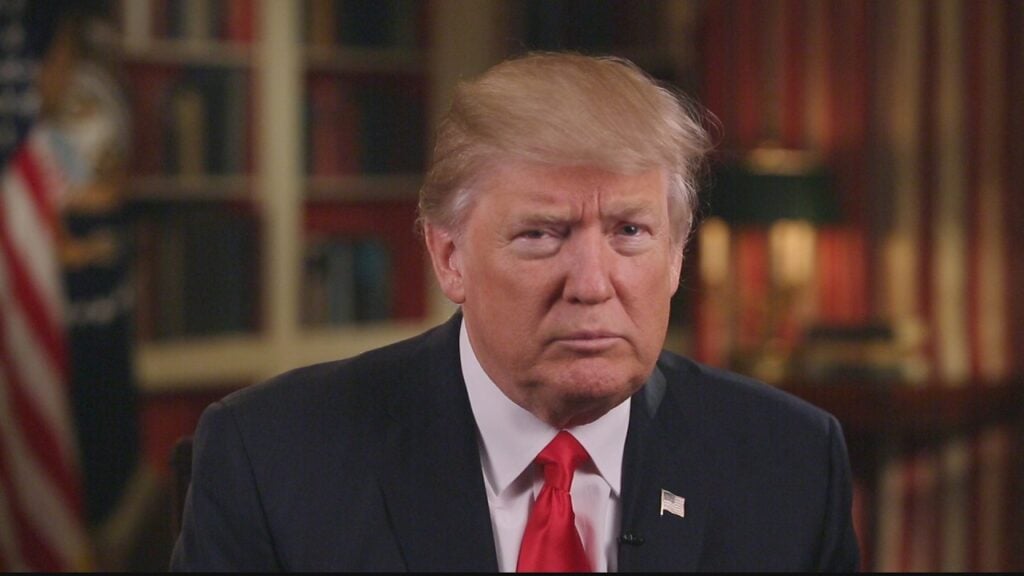The Skinny On Trump’s Skinny Budget: Much Still Unclear
Posted on

President Donald Trump
The Trump administration’s long awaited “skinny budget”, officially named “America First: A Budget Blueprint to Make America Great Again”, has arrived.
It confirms the $54 billion increase in defense, and proposes to add $30 billion to this year’s (fiscal 2017) budget. It provides a description of what the Trump administration hopes to achieve in defense and it continues the war funding’s (“OCO’s”) customary function as the grease in the gears of the budget mechanism. It also leaves unanswered the key question: how big will the Trump defense buildup really be? Let’s take a look at each of these.
The $54 billion increase is measured from the caps set by the Budget Control Act (“sequestration”) and represents about an $18 billion addition to what the Obama administration had forecast. The Obama administration forecast is an important baseline because that is what DoD had already built its current plans on. To the Defense Department, that’s the starting point. The Budget Blueprint divided the $54 billion between the Defense Department ($52.3 billion), the nuclear weapons arm of the Department of Energy ($1.4 billion), and other national security activities ($300 million).
- The proposal calls the increase “one of the largest on-year increases in American history”. The relative size of the increase, though, depends on complicated arguments about the appropriate baseline to use.
- The announcement sets the target for what the Defense Department can spend in fiscal 2018. Thus, there is no detail on what DoD will do with the money. That won’t become available until mid- to late May, when the Trump administration submits the actual 2018 budget to the Congress.
- The defense increase is offset (“paid for”) by cuts to domestic agencies. This is a “double whammy” for domestic agencies because the cut is from a BCA/”sequestration” baseline which, by itself, is significantly below what the Obama administration had forecast. Cuts to the State Department and to the Coast Guard elicited sharp and widespread criticism in the security community because they seemed to act against the effort to increase US security.
-
Although the Budget Blueprint says it “repeals the defense sequestration”, it does NOT propose repealing the Budget Control Act. Rather, it proposes raising the cap for defense—called a “restoration”—but keeps the caps in place. That’s important because it means that any internal proposals for defense increases must be offset by decreases, a discipline that budgeteers appreciate.
The explanatory text is short (two pages), general and partisan — it talks of “rebuilding the Armed Forces,” “restoring critical investments” and “reversing the indiscriminate neglect of the previous administration“— but it does offer a few previews of what the budget will contain:
- “Reverses Army end strength reductions.”
- “Increases the number of Navy ships.”
- “Ensures a ready and fully equipped Marine Corps.”
- “Accelerates Air Force efforts to improve readiness, ensure technical superiority, and repair aging infrastructure”—the only mention of support activities other than maintenance.
- “Initiates an ambitious reform agenda.” This is a wild card that could entail anything from minor efficiencies to major restructurings. Stand by for more on this one.
The Budget Blueprint also proposes a $30 billion increase for defense in this year’s budget, 2017 — $25 billion in the base, half of it offset by cuts to domestic programs, and $5 billion in OCO for increased activities against ISIS. (There’s also $3 billion for Homeland Security.) Because the government is operating under a Continuing Resolution that runs until April 28, and the Congress has not completed final action on a fiscal 2017 appropriation, there is time and opportunity for this amount to be added.

Defense Secretary James Mattis at his first meeting at the Pentagon.
The original expectation was that the 2017 increase would be mostly for readiness. The services had complained vigorously about readiness shortfalls, and Defense Secretary Jim Mattis had highlighted it in his memo initiating the budget process. The proposal does have $7.2 billion for operations and maintenance and another billion for supply stocks. However, the 2017 proposal mostly adds investments. In procurement, it adds $13.5 billion for F-35s, F-18s, Apaches, H-60 Blackhawks, tactical missiles, unmanned aircraft, THAAD, and (part of) a DDG-51 destroyer; for research and development, it adds $2.1 billion for air and ballistic missile defense and cyber. The details are vague because the budget exhibits aren’t ready yet.
The administration continues to use the war funding (Overseas Contingency Operations) to avoid the restrictions of the Budget Control Act and the reservations of deficit hawks, despite OMB Director Mulvaney’s famous opposition to OCO as a “slush fund”. He now apparently appreciates its value as the grease in the budget mechanism. There is no attempt to move any of the enduring costs of OCO to the base. Indeed, the 2018 budget has a $64.6 billion OCO placeholder for defense (and $12 billion for State), implying that the Trump administration will follow the practice of the Obama administration. Further, the 2017 request boasts a $2 billion “OCO Transfer Fund” for needs to be decided later. This is exactly the kind of budget “gimmick” that Mulvaney denounced when he was a member of Congress.
Unanswered is the big question: how large will this defense buildup be? This Budget Blueprint does not contain outyear projections, that is, the amount of money DoD will have in the years FY 2019 and beyond. In its 2009 equivalent announcement, the Obama administration did have an out-year profile, but the Bush administration did not in 2001. We’ll have to wait for the actual fiscal 2018 budget submission in mid- to late May. Perhaps we’ll even have to wait until submission of the 2019 budget in February 2018.
Knowing this is key to understanding whether the buildup is large, medium, or small. For example, if, compared to what the Obama administration forecast, the Trump administration proposes a profile of an $18 billion boost in 2018, a $40 billion boost in 2019, a $60 billion boost in 2020, and ultimately reaching an $80 billion boost in 2021 or so, that will be a buildup of Reaganesque proportions.

Army troops build rope bridge
As CSIS’s Force Cost Calculator estimated, an increase of that size would pay for the force structure expansion, readiness increase, modernization enhancements, and cyber and missile defense improvements that then-candidate Trump described back in September. An increase of this size would get defense spending back to what former Defense Secretary Bob Gates had proposed in fiscal 2012 before the restrictions of the Budget Control Act were imposed by law, and they would approach what Sen. John McCain has proposed in his White Paper, though his proposal would require an increase to about $117 billion over the Obama forecast.
This is only the opening act of a long budget drama. As many experts have noted, the administration will have a hard time getting the defense increase through Congress because of the difficult political dynamics. Aside from the tiny majority of two the GOP holds in the Senate, the party itself is split. Deficit hawks will clash with the budget hawks (Freedom Forum et al). Then the Republicans will clash with the Democrats over domestic spending. In the background lies the threat of more political paralysis, Continuing Resolutions, and, yes, even another government shut down. It’s going to be a great show. Stay tuned.
Subscribe to our newsletter
Promotions, new products and sales. Directly to your inbox.
